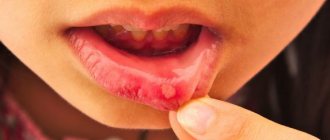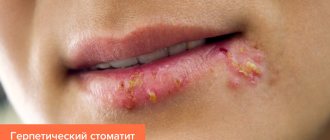What is stomatitis
Stomatitis (mucositis) is a disease that is accompanied by damage to soft tissues in the oral cavity.
It can be either an independent disease or a complication of various pathological processes, for example, measles, influenza, scarlet fever, etc. Until recently, stomatitis was considered a childhood disease. Today it is becoming more common in adults too. This trend raises questions about whether stomatitis is transmitted and, if so, how to protect yourself and your child. It all depends on the form of manifestation of the disease
Prevention of stomatitis
All measures aimed at preventing stomatitis in adults and children coincide with preventive measures against the occurrence of caries and other dental problems. The main recommendations are a healthy lifestyle, adequate oral hygiene and timely visits to the dentist.
We remind you that for preventive purposes you need to visit the dentist’s office once every 6 months - even if nothing bothers you.
We invite you to Genesis for a preventive examination! ←Return to list of articles
Symptoms of stomatitis
Stomatitis can be recognized by the following signs:
- ulcers, wounds, erosions and rashes on tissues;
- red color of the mucous membrane;
- plaque on the tongue, inner surface of the cheeks, palate;
- unpleasant taste;
- swelling of tissues;
- heavy salivation;
- bad breath;
- itching and burning – in some cases;
- discomfort and pain;
- bleeding gums – occasionally;
- increased body temperature;
- lymphadenitis.
Symptoms in children are always more pronounced. The child often feels severe pain. Adults tolerate the disease easily. Its symptoms usually do not cause severe discomfort.
When the first symptoms appear, you should immediately consult a doctor to protect yourself and, possibly, others.
Causes
Viral stomatitis in childhood develops due to various infections, since the baby has an underdeveloped immune system. He does not have time to recover from his previous illness. It also easily becomes infected from a patient with stomatitis. The situation is worsened by a lack of nutrients and vitamins in the body.
The disease in children is caused by the following pathogens:
- flu;
- HIV;
- mononucleosis;
- measles;
- papillomavirus;
- ARVI;
- enterovirus;
- chicken pox;
- herpes.
Most often, herpes is the causative agent of this disease; it accounts for up to 80% of all cases. Most of these viruses are persistent intracellular parasites. Therefore, this disease often becomes chronic. With this form, there is an alternation of exacerbations and remissions. The acute form can result in the formation of a carrier state, in which the pathogen remains in the cells, but there are no symptoms of the disease.
Most often, the infection affects children under four years of age. But it affects older children and teenagers.
The reasons why this happens are:
- undeveloped immune system;
- insufficient oral hygiene;
- weakness of local immunity;
- injuries to the gums and oral mucosa;
- general weakening of the body after an illness;
- long-term use of certain drugs (glucocorticoids, antibiotics, cytostatics).
Parallel inflammatory processes in other organs and systems also contribute to maintaining the infectious process in the mouth of children.
Types of disease
Stomatitis has different forms, depending on which the doctor determines whether it is contagious or not, and also prescribes appropriate treatment.
Allergic stomatitis
This is a common form of the disease that is difficult to treat. From the name it is clear that the cause of its development is an allergy, but it is necessary to find out what exactly it is. These could be medications, food, materials used for prosthetics. The disease is accompanied by the appearance of ulcers, which provoke pain.
Viral stomatitis
The most common type of viral stomatitis is herpetic stomatitis, the causative agent of which is the herpes virus. There are other forms that are provoked by adenovirus, enterovirus, etc. They are often found in children under 5–6 years of age, but are also common among older age groups. A feature of viral stomatitis is its erosive spread, when one ulcer appears next to another. Herpes mucositis may cause complications such as fever, nausea, vomiting and diarrhea.
This form of the disease is transmitted to others by contact and airborne droplets. If it is diagnosed, for example, in someone in kindergarten, then quarantine must be introduced. Infection occurs through dishes and toys, so the disease can quickly spread from child to child.
The virus spreads from nursing mothers to children if hygiene rules are violated. Adults become infected even through handshakes. Sneezing also causes the disease to develop.
Aphthous stomatitis
This form is common among adults. It develops against the background of a weakening of the body’s immune forces, so aphthous stomatitis is a common occurrence in spring and autumn. With this type of disease, characteristic aphthae appear - small ulcers. They can be single or group. Aphthous mucositis is not spread from person to person.
Fungal stomatitis
The disease manifests itself in children and adults, mainly in infants and women. It is provoked by fungi of the genus Candida, which are activated in the oral cavity when the immune system is weakened. The cause of fungal stomatitis can be long-term use of antibiotics. In addition to ulcers, its characteristic feature is a cheesy coating on the tongue, palate and inner surface of the cheeks.
Bacterial stomatitis
This type of disease is diagnosed when the oral cavity is affected by microorganisms, most often streptococci, staphylococci. The manifestation of bacterial stomatitis is provoked by tuberculosis, as well as sexually transmitted diseases, for example, gonorrhea, syphilis. More often, children whose immunity is not strong enough suffer from it. But everyone must be careful. The disease is transmitted from children to adults through dishes, toys, and damage to the mucous membrane.
This form is characterized by swelling in the oral cavity, redness of the mucous membrane and hardening of the palate, as well as an unpleasant odor, ulceration and cracks. Symptoms of intoxication may appear: vomiting, weakness, rapid pulse.
Other forms of stomatitis
In addition to the above types of disease, the following can also be distinguished:
- chemical stomatitis - occurs as a result of burns to the oral cavity with alkaline substances or acid;
- traumatic - ulcers are formed as a result of impact and disruption of tissue integrity;
- radiation – develops as a result of radiation.
Such forms are non-contagious and therefore do not pose a danger to other people.
Stomatitis - symptoms and treatment
The main goal of treating stomatitis is to prevent the lesion from spreading throughout the entire oral mucosa and to prevent the disease from becoming chronic. First of all, it is necessary to determine the form and stage of the disease, since treatment tactics will depend on this. Treatment is complex: both local and general.
For all types of stomatitis, professional oral hygiene . It is the removal of dental deposits such as tartar and soft pigmented plaque.
Effective drugs for the treatment of stomatitis in adults
Next, it is necessary to eliminate chronic foci of infection and predisposing factors. For painful ulcers, anesthesia of the oral mucosa :
- applications of a 2% solution of procaine (Novocaine);
- applications of 2% lidocaine solution [7].
The affected mucous membrane is treated with antiseptics (0.02% Furacilin solution; 0.06% chlorhexidine solution; 0.1% Dimexide solution).
Applications of collagen films with various medicinal substances, for example, corticosteroid drugs, Diphenhydramine, and anesthetics, are also used. This film attaches to the erosion and has anti-inflammatory and antiallergic effects, after which it dissolves on its own. To accelerate the healing of the mucosal epithelium, an oil solution of vitamin A, rosehip oil, and dental adhesive paste with solcoseryl are used.
How can you rinse your mouth for stomatitis?
When treating stomatitis, it is very important to identify the cause and eliminate it. Rinsing the mouth with antiseptic solutions (0.02% Furacilin solution, 0.06% Chlorhexidine solution) or herbal decoctions will reduce swelling and inflammation, but this is not the main method of treatment.
General treatment
Includes adherence to a diet (it is not recommended to consume spicy, spicy, rough foods, alcoholic beverages), as well as the use of antihistamines, antivirals, antibacterial, antifungal drugs (depending on the form of stomatitis) and sometimes glucocorticosteroids (GCS) - analogues of natural hormones of the adrenal cortex [6 ].
Desensitizing therapy : orally “Tavegil”, “Diphenhydramine”, “Suprastin”, 1 tablet 2 times a day for a month.
Antifungal therapy is carried out for candidal stomatitis: tablets “Nystatin”, “Nizoral”, “Diflucan” [9].
For viral stomatitis, antiviral drugs are prescribed: Lavomax, Valtrex, Bonafton. In severe forms of stomatitis, corticosteroids can be prescribed: prednisolone 15-20 mg per day, the dose of the drug is reduced by 5 mg per week from the moment of epithelization of erosions and ulcers.
For stomatitis, restorative therapy . Vitamins of group B, C, PP. Imudon tablets have an antiseptic effect, normalize microflora, and increase local immunity [11].
From the first day of the patient’s treatment until complete epithelialization, physiotherapy : ultraviolet irradiation, helium-neon laser, laser biostimulation of blood.
Laser treatment of stomatitis
Laser in the treatment of stomatitis is especially effective if the oral mucosa is affected by bacteria, viruses or fungi. The laser beam is targeted specifically at the affected area of the mucous membrane without damaging healthy tissue. The method allows you to destroy microbial cells, reduce pain and swelling, improve microcirculation, which promotes healing. The procedure is painless and safe.
How to cure stomatitis in a child
The principles of treating stomatitis in children and adults are similar, but it is important for the doctor to take into account the age of the child and correctly calculate the dosage of drugs. Another feature is that young children will not be able to rinse their mouths or use mouth baths. Therefore, antiseptic treatment of the oral cavity is carried out by parents with a finger wrapped in several layers of gauze and soaked in an antiseptic solution.
Treatment of stomatitis at home
If symptoms of stomatitis appear, you should immediately consult a doctor. Self-diagnosis and treatment with folk remedies often aggravate the disease.
Ways of transmission of stomatitis
Let's summarize. Viral, bacterial and herpetic forms of stomatitis are contagious. Knowing how the disease is transmitted, you can protect yourself and your loved ones. Ways of transmission of infection:
- airborne - sneezing, coughing;
- household items - common dishes, linen, personal items;
- toys, raw pacifiers, rattles;
- dirty hands;
- unwashed food;
- biological fluids - through saliva, blood, breast milk;
- Pets can carry the virus.
It is possible to catch the infection anywhere – from the street to your own home. You can get infected from both a child and an adult.
Features of the spread of stomatitis in children and adults
Children under the age of 3-4 years are at risk because they have a poorly developed immune system and the body cannot independently resist the activity of pathogens. Infection most often occurs through direct contact, toys and airborne droplets.
Reference! It is more difficult for a healthy adult to become infected from a child; this usually occurs due to malfunctions of the immune system, diabetes mellitus and infection with viruses, which can additionally provoke the appearance of stomatitis.
The occurrence of the traumatic form of the disease does not depend on age.
The likelihood of contracting aphthous stomatitis
People with serious chronic diseases are susceptible to aphthous stomatitis. Most often these are diseases:
- Oral cavity.
- Throat.
- Upper respiratory tract.
The presence of a focus of infection weakens local immunity. The consequence is the appearance of blisters, ulcers, and plaque. A yellow-white coating is characteristic. Erosive changes become pronounced if left untreated.
The disease may not cause concern for a long time. In any disease, with exacerbation of chronic diseases, the eroded surfaces become painful.
The risk of developing aphthous stomatitis increases:
- Poor nutrition .
- The presence of long-term non-healing wounds in the mouth.
- Presence of untreated teeth.
- Gum diseases .
- Incorrectly fitted dentures .
- Oral injuries
Diet for stomatitis
Stomatitis often worries children, becoming a consequence of insufficient immune forces of the body, weakened by some disease.
Aphthous stomatitis is typical for those suffering from diabetes.
Aphthous stomatitis itself is not contagious. Communication with a person who has signs of the disease is not dangerous. The risk of infection arises when a patient with aphthous stomatitis “adds” a viral infection to the underlying disease.
Redness of the throat may indicate pharyngitis, purulent discharge from the tonsils may indicate tonsillitis. In these cases, the pathogen is transmitted to a healthy person through contact with a sick person.
Predisposing factors and risk groups
It is known that 50% of people are carriers of fungal microflora, and under normal conditions it can be in a kind of “dormant” or suppressed state in the form of chlamydospores, resistant to the external environment. This is why fungal microflora can be transmitted from person to person (i.e., it is contagious). However, under certain conditions, the fungus can begin to multiply rapidly, form colonies and lead to thrush in the mouth (candidal stomatitis). Moreover, under certain conditions, this disease can recur in both children and adults (chronic candidal stomatitis). There are many factors that predispose to this disease and form risk groups for candidal stomatitis in adults and children.
General decrease in immune defense. Can be caused by pregnancy, general diseases (diseases of the gastrointestinal tract, diabetes mellitus, tuberculosis, immunodeficiency states), long-term use of medications (especially antibiotics, corticosteroids, cytostics), dysbacteriosis, avitaminosis (lack of vitamins B, C, PP) , bad habits (alcohol, smoking).
Infants and elderly people. Children, up to about the seventh month of life, and the elderly, due to imperfect or reduced immune defense, are especially susceptible to this disease. Moreover, when diagnosed with chronic candidal stomatitis, a thorough immunological examination is necessary.
Local factors. For example, injuries to the oral mucosa (due to malocclusion of the dentition, chipped tooth enamel). Another common case is removable dentures, which, with insufficient hygiene, contribute to the proliferation of fungal microflora or injure the mucous membrane. Local factors include allergic reactions to dental materials, when allergic stomatitis initiates the appearance of fungal stomatitis.










